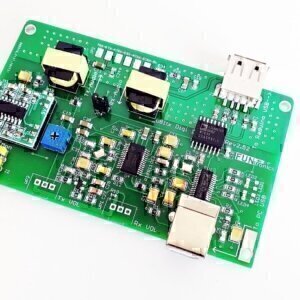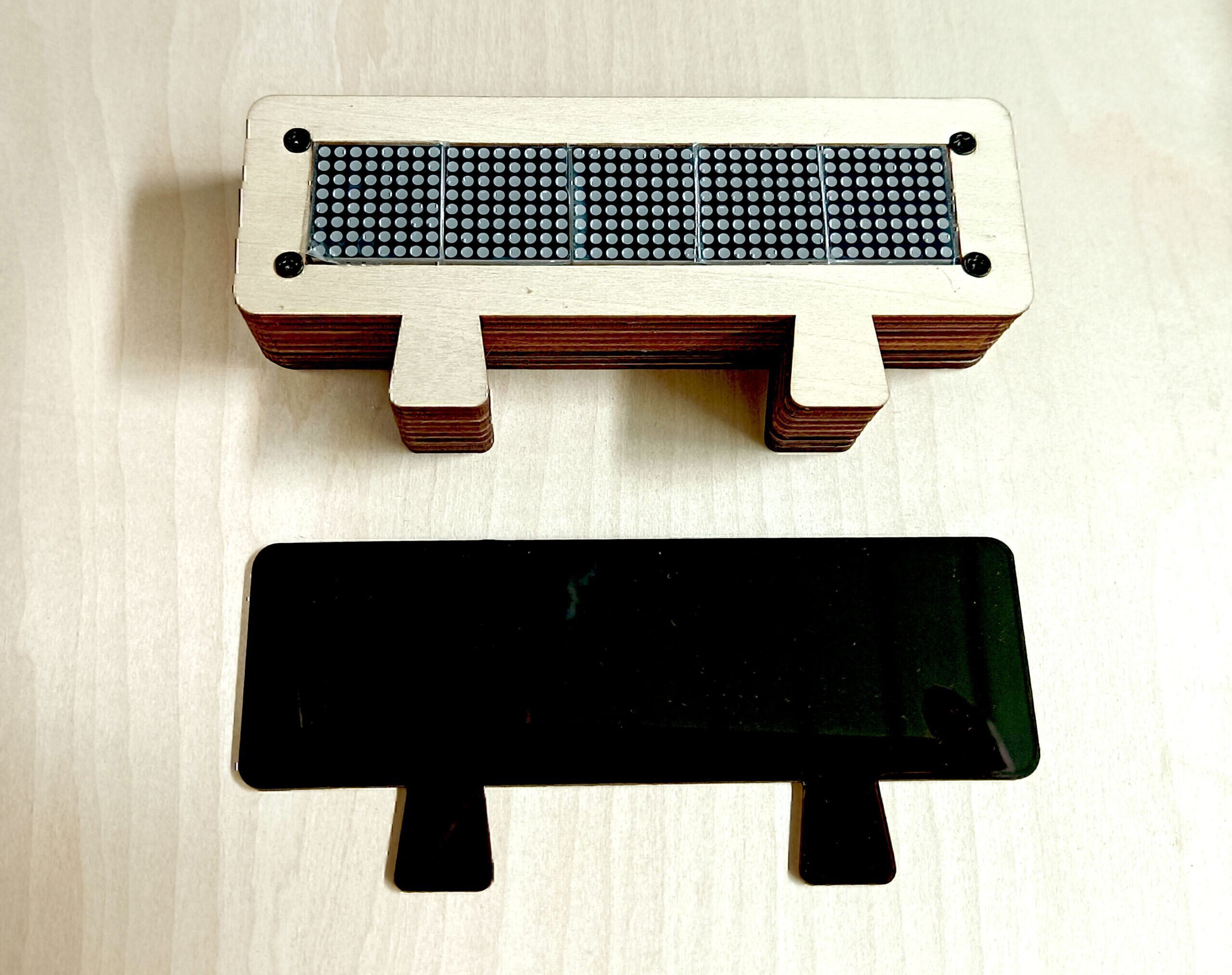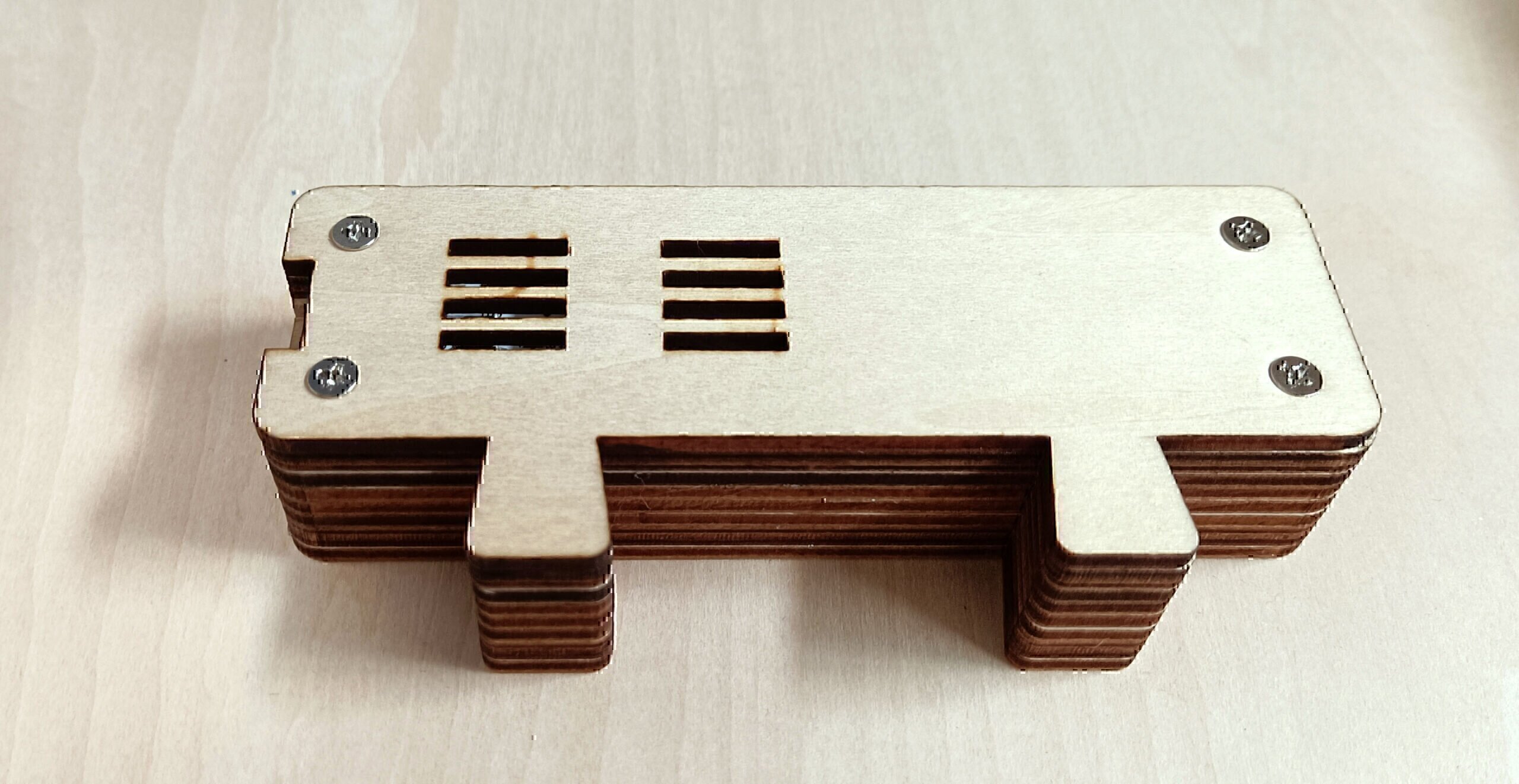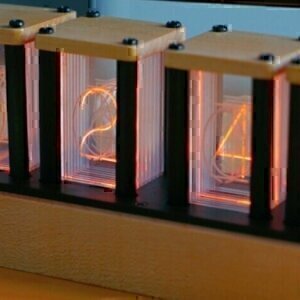LED Matrix Clock Kit | ESP8266 Clock with MQTT | LED Matrix Info Display
$39.99 – $41.99 (EU VATs Exclude)
SKU: L10003
Categories: Desktop Ornaments, Featured Products, New Products, Radio Acces
Tags: clock, desktop widgets, everyday electronics, ham radio
Projects of electronic clocks may probably be the most popular diy projects in maker circle in recent years. Most of these projects are not difficult to build, and meanwhile you will gain a lot on coding in Arduino. With the capability of wifi, ESP series SOCs will add more funs in clock projects. The clock kit introduced here comes with 2 pcb boards, one is for display and the other is the main board. The display board consists of 5 blocks of 8×8 led matrix, and MAX7219 as the driver. On the main board, an ESP8266 as the core, a DS3231 as the RTC, 2 buttons and 1 buzzer are also integrated on the board. Setting the RTC via ntp service is really simple with the ESP8266. The kit comes with sample codes in Arduino C++, you can use the code to make it work as a led matrix clock or you can write your code to let it be a message display board. A python program (with source code) is also provided for sending MQTT messeages (weather or other info) from PC to the clock. You can deploy the program in a raspberry Pi, then it will send the weather info to your clock hourly. The enclosure (cut by plywoods) is also included in the package.
Notice: The price here is valued for the hardware and postage, the firmware code is free, as the code is fully open. We are not responsible for the firmware bugs in current code implementation including python codes. I am not an expert in both of them.


Features:
- Small in size, could be put on your desktop as the desktop onerment.
- 5x8x8 led matrix with wifi, info could be sent remotely.
- For clock, UTC and Local time switchable.
- For clock, it is able to display your name (7 letters only) or callsign (for ham radio, 7 letters or digits only) periodically.
- For clock, clock settings is configured with web.


In Arduino Code:
You have to supply your WiFi SSID and PASSWORD if you use the simple sample code.


If you use the advanced code, you do not have to supply your WiFi credentials in the code, as it uses your phone to do the WiFi settings and other configurations. But, you have to upload the SKETCH DATA first of all (config.json), and then compile and upload the code.

The config.json file in spiffs.


A python program could be used to send mqtt messages and weather info to the led matrix if the advanced code is used.

Downloads:
- Arduino: code and libraries (libraries needed: PubSubClient, WiFiManager, ArduinoJson(5.x), put them in your arduino’s libraries folder)
- Arduino: new Arduino code and libraries with ArduinoJson6.0, littlefs(use “ESP8266 LittleFs Data Upload” to upload the config.json file)
- Schematics: display board, main board
- Python: source code and compiled EXE for windows (libraries needed: pysimpleGui, pyOwmGet, paho, json, ast, time)
Specification:
- Voltage In: DC 5V with Type-C
- Working Current: 200mA
- Wireless: WiFi 2.4G
- LED Matrix: 5x8x8
- Size:125 x 54 x 28 mm
- Weight: 100g
Package Includes:
- LED Matrix Display Board x 1
- Main Board with ESP and RTC x 1
- Plywood Enclosure Set x 1
- Screws and Standoffs Set x 1




| Weight | 0.3 kg |
|---|---|
| Dimensions | 180 × 100 × 30 mm |
| LED COLOR | WHITE, RED, BLUE, GREEN |
Only logged in customers who have purchased this product may leave a review.
You may also like…
-
New Products
Lixie Clock Nixie Clock | New and Modern Nixie | RGB LED Clock
Rated 0 out of 5$119.99Original price was: $119.99.$99.99Current price is: $99.99. (EU VATs Exclude) Select options This product has multiple variants. The options may be chosen on the product page
Product categories
Product tags
active antenna
antenna
antenna analyzer
antenna tuner
arduino shield
battery tester
clock
dc-dc step down
dc-dc step up
desktop widgets
dsp
electronic load
electronic module
esp32
esp8266
everyday electronics
ham radio
ham radio shack oraments
home assistance
iot projects
light & art
lixie
matrix display
measurement tools
neopixels
nixie
postage
power module
preamps
radio acce
radio accessories
radio transceiver
sdr radio
shortwave listening
smart home
spot welder
uBitx
weather sensors
weather station kit
zigbee
Popular Products
-
 AT-100M Pro Antenna Tuner | Power SWR Meter with OLED | Field Tuner for Your Portable Radios$97.50 (EU VATs Exclude)
AT-100M Pro Antenna Tuner | Power SWR Meter with OLED | Field Tuner for Your Portable Radios$97.50 (EU VATs Exclude) -
 WEB-888 16Bit SDR Receiver 62MHz Bandwidth | OpenWebRx Pre-Installed | HF/VHF GPS SDR
WEB-888 16Bit SDR Receiver 62MHz Bandwidth | OpenWebRx Pre-Installed | HF/VHF GPS SDR$308.00Original price was: $308.00.$257.99Current price is: $257.99. (EU VATs Exclude) -
 New digiPi HAT | Ham Radio digi Modes APRS FT8 FT4 Winlink from Raspberry Pi | KM6LYW digiPi Image$34.00 – $51.99 (EU VATs Exclude)
New digiPi HAT | Ham Radio digi Modes APRS FT8 FT4 Winlink from Raspberry Pi | KM6LYW digiPi Image$34.00 – $51.99 (EU VATs Exclude) -
 RadioBerry V2.0 SDR Board | AD9866 Hermslite SDR | Raspberry Pi SDR HAT for HF 1-30MHz TRX Board
RadioBerry V2.0 SDR Board | AD9866 Hermslite SDR | Raspberry Pi SDR HAT for HF 1-30MHz TRX Board$153.90Original price was: $153.90.$123.99Current price is: $123.99. (EU VATs Exclude) -
 truSDX digi Interface | truSDX Sound Card FT8CN WSJTX
truSDX digi Interface | truSDX Sound Card FT8CN WSJTX$26.50Original price was: $26.50.$15.99Current price is: $15.99. (EU VATs Exclude) -
 Q900 SDR Radio Transceiver V4 | Built-in Battery Portable FT8$535.99 – $749.99 (EU VATs Exclude)
Q900 SDR Radio Transceiver V4 | Built-in Battery Portable FT8$535.99 – $749.99 (EU VATs Exclude)
-
 NPR-70 v05 Modem by F4HDK | New Packet Radio over 70cm Band | Amateur Radio Packet Radio | Factory-Assembled
NPR-70 v05 Modem by F4HDK | New Packet Radio over 70cm Band | Amateur Radio Packet Radio | Factory-Assembled$102.00Original price was: $102.00.$91.99Current price is: $91.99. (EU VATs Exclude) -
 FAA-450 Antenna Analyzer (EU1KY)$40.00 – $228.00 (EU VATs Exclude)Rated 5.00 out of 5 based on 3 customer ratings
FAA-450 Antenna Analyzer (EU1KY)$40.00 – $228.00 (EU VATs Exclude)Rated 5.00 out of 5 based on 3 customer ratings -
 New digiPi HAT | Ham Radio digi Modes APRS FT8 FT4 Winlink from Raspberry Pi | KM6LYW digiPi Image$34.00 – $51.99 (EU VATs Exclude)
New digiPi HAT | Ham Radio digi Modes APRS FT8 FT4 Winlink from Raspberry Pi | KM6LYW digiPi Image$34.00 – $51.99 (EU VATs Exclude) -
 uBitx Digi-Interface Module (Add-on Board)$39.99 (EU VATs Exclude)Rated 5.00 out of 5 based on 2 customer ratings
uBitx Digi-Interface Module (Add-on Board)$39.99 (EU VATs Exclude)Rated 5.00 out of 5 based on 2 customer ratings -
 External SPI-SRAM Add-on Board for NPR-70 v04 | New Packet Radio over 70cm Band | Amateur Radio Packet Radio$9.99 (EU VATs Exclude)
External SPI-SRAM Add-on Board for NPR-70 v04 | New Packet Radio over 70cm Band | Amateur Radio Packet Radio$9.99 (EU VATs Exclude) -
 VHF/UHF RF Power Amplifier for DMR | Handheld Radio Amplifier | Ham Radio$149.99 (EU VATs Exclude)
VHF/UHF RF Power Amplifier for DMR | Handheld Radio Amplifier | Ham Radio$149.99 (EU VATs Exclude)






Reviews
There are no reviews yet.